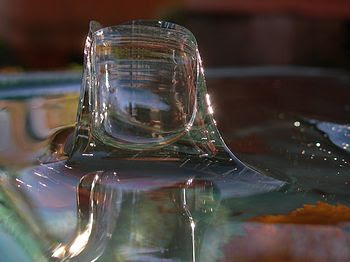The Bog Orchid -
Hammarbya paludosa - is a rather rare orchid which grows in scattered locations throughout the UK, particularly in the west of Scotland. It flowers from late July to September.
I was keen to see this tiny orchid, and jumped at the opportunity when, on 1st September 2002, I was invited to go and look for it at a location where it had been found before. Unfortunately the arranged trip fell through, but I decided to go and have a hunt for myself in a different area, preferring somewhere less remote when walking alone.
I hadn't been walking for long before I came to a likely looking boggy area. You can imagine my astonishment when I found 14 Bog Orchids scattered along the side of a small stream! This was within a site which was already designated as an SSSI, but Bog Orchids had never been found there before. This site in Stirlingshire has continued to be a reliable location, and this year we found 51 flowering spikes there.

Bog Orchid at the site found in 2002, 8th August 2009
This was certainly a case of beginner's luck. Although we later found them at the site which we had intended to visit on that first day, I did not see them at any other location until this year despite looking out for them in any bogs I happened to be passing.
On 22nd August this year I went hill walking with a group. The pace was rather fast for flower hunting, but I can't walk anywhere at this time of year without keeping a look-out for anything unusual. We hadn't walked far before I noticed 2 Bog Orchids beside a wet flush, and 4 more close by. I could not stop to look for more, but on the way down I made sure that I was ahead of the rest and found a total of 9 flowers. This site in Perthshire was also an unknown location for the orchid.

To give some idea if the small size of this orchid, the length from the bottom of the lowest floret to the top of the spike in this picture measured 13mm. In the Bog Orchid the flowers twist through 360 degrees rather than the 180 degrees of most other orchid florets - so the florets appear upside-down compared to other orchids. The green-striped lip can be seen at the top of the upper floret on the right.
Since I discovered this site, I was asked to check on a site in Perthshire where this orchid had been found in 1999 but the grid reference was thought not to be accurate and it had not been seen since. This was a real challenge, as the Bog Orchid particularly likes growing on moss or peat where it is alongside a stream or water with some movement, and it turned out that the whole area was suitable habitat with many wet areas, small streams and bogs. Fred came with me, and we searched all the likely areas, working in a zigzag from the first stream we came to until we reached the given grid reference. We had searched for more than an hour and were about to give up when I suddenly found one.
The site was typical - a wet flush with water trickling down it into a nearby stream.

My stick marks the location of this plant.
Perhaps because it was towards the end of the season, it had quite a yellowish colour which made it slightly easier to spot, and a further search produced 7 more flowers.

The picture below shows this plant in its habitat, with a Round-leaved Sundew growing nearby on the left.
 On the 26th we noticed a large thrush-like bird in one of the trees opposite. It made a brief visit to our garden to collect a cotoneaster berry. Viewed through the binoculars, it turned out to be a fieldfare, which is a new record for our garden. I tried to take a photo, but at that moment it took off so this is all I managed to get.
On the 26th we noticed a large thrush-like bird in one of the trees opposite. It made a brief visit to our garden to collect a cotoneaster berry. Viewed through the binoculars, it turned out to be a fieldfare, which is a new record for our garden. I tried to take a photo, but at that moment it took off so this is all I managed to get. In the evening we were just going out for a night walk in the snow when we were astonished to see a pair of mallard ducks approaching our house. They seemed to recognise us when we appeared, and we can only think that they were a pair that visit us in summer and could find no open water in the cold weather. They were certainly very hungry. We have ducks visiting our garden every year, but only between late March and August.
In the evening we were just going out for a night walk in the snow when we were astonished to see a pair of mallard ducks approaching our house. They seemed to recognise us when we appeared, and we can only think that they were a pair that visit us in summer and could find no open water in the cold weather. They were certainly very hungry. We have ducks visiting our garden every year, but only between late March and August. 

















































